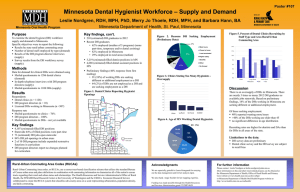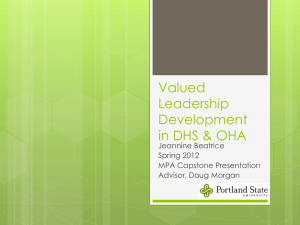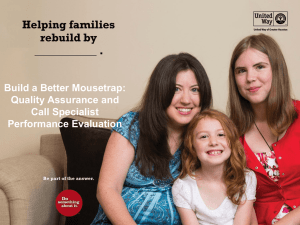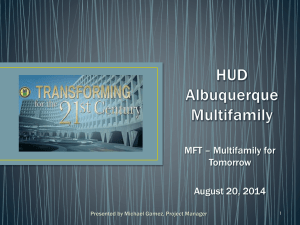The Dream of Owning Your Own Home
advertisement
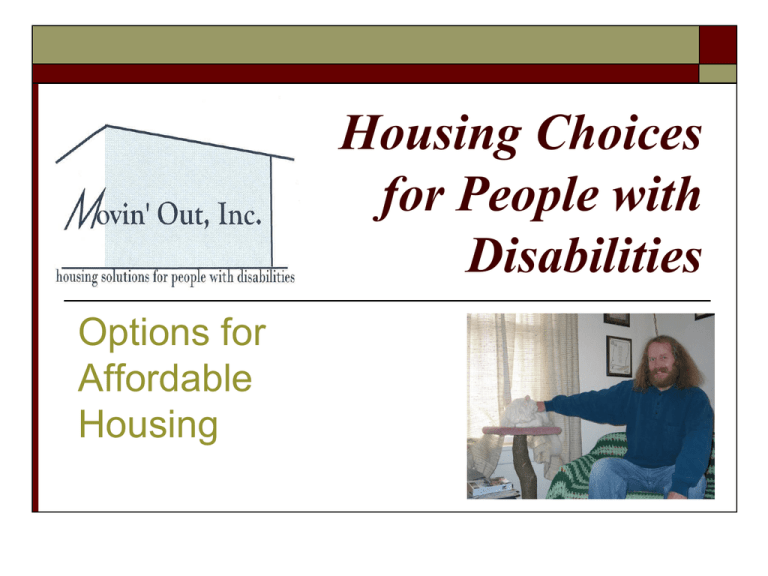
Housing Choices for People with Disabilities Options for Affordable Housing Typical Housing What are the housing choices available? Parents’ Home A licensed home managed by others Rent with a lease Home Ownership DHS Initiatives 7 Agenda Learn briefly about the HUD Section 811 reforms Learn how DHS and the Wisconsin Housing and Economic Development Authority (WHEDA) are planning to work together thru new proposed initiatives 8 The New Federal HUD Section 811 Program Integration: Number of units for supportive housing for persons with disabilities (including those to which any occupancy preference for person with disabilities applies) may not exceed 25% of the total units in the housing project. 9 The New Federal HUD Section 811Program Target population: Only very low income households with at least one non-elderly adult with disabilities between the ages of 18-61 are eligible. 10 The New Federal HUD Section 811Program Supportive Services: Long term care services must be made available to tenants and provided through Medicaid waivers, but must be voluntary. 11 The New Federal HUD Section 811Program Housing separate from services: Supportive housing units will be owned by non-profit and for-profit organizations, not service providers or affiliates. 12 The New HUD Section 811 Program in Wisconsin Target population: 1) Those eligible persons currently residing in institutions or nursing homes, who may also qualify for the “Money Follows the Person” program. 2) Those eligible persons who may be at risk of institutionalization, who currently live in substandard housing or who are not living where or with whom they choose. 13 DHS/WHEDA Housing Grant The goal of the project is to develop individualized, integrated, accessible, affordable and safe housing for Medicaid-eligible persons with disabilities who are interested in family-oriented, self-directed, and consumer-focused housing. 14 Section 811 Notice of funding availability (NOFA) WHEDA as lead applicant, DHS supporting. Application completed August 2012, awards expected to be announced mid-November 2012. Applied for $3,013,154 which is expected to produce 300 Section 811 units over a 5-year period (60 per year). 15 Units may be available as early as Spring 2013 Step # Who is responsible Step 1: Verification of Eligibility Designated community referral sources Step 2: Certificate of Eligibility DHS Housing Specialist The Screening List DHS Housing Specialist Step 3: WHEDA Preliminary Review WHEDA Program Specialist The Section 811 Waitlist Step 4: Financial Verification and the Lease What is their role Verify eligibility for long term support and disability programs and need for housing. Refer to DHS Housing Specialist. Review verification from community. Produce Certificate of Eligibility, referral letter and preliminary application. Present to WHEDA Program Specialist. Manage a Screening List to track eligible applicants who have cleared the disability and long term care program eligibility steps. Verify paperwork, contact owner regarding unit availability and forward application. Oversight for this step DHS DHS DHS WHEDA WHEDA Program Specialist If units are full, WHEDA Program Specialist manages the waitlist. WHEDA Property owner/ management agent Complete Financial Verification, physical inspection and rental agreement. WHEDA 16 What will these new housing opportunities look like? Elven Sted Community-supporting amenities Visitable, Barrier-Free Supportive Services Inclusive Elven Sted Infill development 2.5 acres HOME funds TIF BEBR WHEDA Tax Credits 32 LIHTC units; 1 market rate unit Community Living Connections Residential supportive services onsite Wide range of support needs Support services require no licensure CLC rents market rate unit Home for caregiver Office for CLC staff Location of Sound Response monitoring staff Sound Response Provides support to individuals primarily during the hours of 9pm-7am using technology Uses a system that includes monitoring and responding Fosters independence Sound Response costs 1/3 of staff cost System Efficiencies Long-Term Care in Community Settings A third of Family Care costs are spent for services to individuals in assisted living or alternative residential settings. Costs for these persons are 2 to 3 times higher than for those living in their own homes. Long-Term Care in Community Settings Ensure that people with long-term care needs are safe and cared for in their own homes and community settings…in the least restrictive and most integrated location to meet the person’s needs. Why looking at housing options is important Acuity-based guidelines could be established that will limit use of licensed housing options Rate adjustments that de-emphasize bundled service + housing Expand ADRC options counseling to include information on non-restrictive housing options Expand implementation of supportive housing methods and technologies Contact Info: Howard Mandeville, Executive Director Movin’ Out, Inc. (608) 251-4446 howard@movin-out.org Maura Klein, Housing Specialist Department of Health Services (608) 266-2905 maura.klein@wisconsin.gov 33 More info at www.movin-out.org





